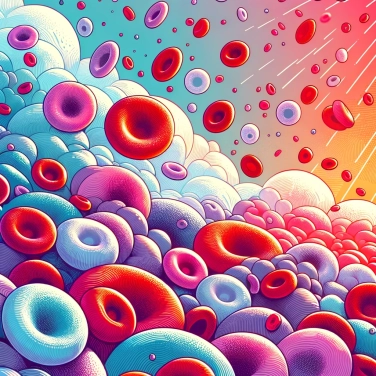Red blood cells have a biconcave shape in order to maximize their surface area for easier gas exchange and oxygen transport. This shape also allows red blood cells to pass through the narrow capillaries in the body.

Red blood cells have a funny shape: a flattened center, somewhat resembling a donut without its hole completely pierced. This is called a biconcave shape because it is hollowed out on both sides. This particular morphology primarily arises from the absence of a nucleus in these cells when they reach maturity, leaving them more space for hemoglobin, the molecule that carries oxygen. It is during their development in the bone marrow that red blood cells lose their nucleus and take on this unique shape. This structure allows them to be very flexible and to provide a large surface area for effectively capturing and releasing oxygen.
The particular shape of red blood cells, flattened and biconcave, provides them with a large surface area for exchange. This allows oxygen and carbon dioxide to bind and pass through quickly, as these gases easily cross the thin membrane. Moreover, this shape gives the red blood cell top flexibility, enabling it to easily squeeze through the smallest blood vessels, like tightly packed capillaries. This adaptability prevents blockages and ensures efficient oxygenation throughout the body, even in hard-to-reach corners. It's a bit like a soft cushion that can bend slightly without bursting.
The specific shape of red blood cells primarily depends on the flexible and robust network located just beneath their membrane, called the membrane cytoskeleton. This network resembles a kind of very fine fishing net made mainly of proteins called spectrin and actin, which provide elasticity and mechanical strength to the cell. Additional proteins, such as ankyrin and band 3, play a key role in securely "anchoring" this net beneath the membrane. Thanks to this system, red blood cells remain flexible and retain their famous biconcave disc shape, which is so valuable to them. This clever little mechanism allows red blood cells to easily navigate through even the tiniest blood vessels.
When the shape of red blood cells becomes deformed, it can quickly lead to problems. For example, in the case of sickle cell disease, these cells become rigid and take on a crescent shape: as a result, they easily block small blood vessels. This causes severe pain and reduces the supply of oxygen to the tissues. Other abnormalities, such as overly spherical red blood cells in spherocytosis, are eliminated too early by the spleen, causing fatigue and anemia. In short, poorly formed red blood cells open the door to circulation problems, disrupted oxygen transport, and a general decrease in daily energy.
Blood owes its red color to hemoglobin, a protein found in large quantities in red blood cells, which captures oxygen and gives it this characteristic hue.
Mature red blood cells in mammals have neither a nucleus nor mitochondria, which allows them more internal space to carry more oxygen.
In an adult, approximately 2 million new red blood cells are produced in the bone marrow every second to replace those that are worn out or destroyed.
At high altitudes, the body produces more red blood cells to compensate for the scarcity of oxygen. This is why many athletes train in the mountains to enhance their performance.
Several conditions can arise from a change in the shape of red blood cells, such as sickle cell disease (sickle shape), hereditary spherocytosis (spherical shape), or elliptocytosis (elliptical shape). These morphological abnormalities compromise blood circulation and the ability to transport oxygen efficiently.
Yes, red blood cells have a high membrane flexibility that allows them to bend or stretch in order to pass through extremely narrow blood capillaries. This is made possible by the soft lipid bilayer structure of their cell membrane as well as their unique cytoskeleton, which facilitates deformation and the return to their original shape.
On average, red blood cells have a lifespan of 120 days. After this period, they age and are primarily eliminated by the spleen, where they are replaced by new red blood cells produced by the bone marrow.
The production of red blood cells is regulated by a hormone called erythropoietin, which is primarily produced by the kidneys in response to low oxygen levels in the blood. When the oxygen content decreases, erythropoietin stimulates the bone marrow to produce more red blood cells, thereby restoring adequate oxygenation levels.
Red blood cells lose their nucleus during maturation in order to maximize their internal space for transporting more hemoglobin. This significantly increases their capacity to carry oxygen to the body’s cells.

No one has answered this quiz yet, be the first!' :-)
Question 1/5